Level 2 Certificate: Understanding Health Sector - Unit 4 Assessment
VerifiedAdded on 2023/04/22
|19
|4984
|196
Homework Assignment
AI Summary
This is a solved Level 2 certificate assignment focusing on health, safety, and security within the health sector (Unit 4). It covers the identification of potential risks to health, safety, and security in healthcare settings related to the environment, individuals, and information. The assignment outlines methods to minimize these risks, identifies key legislation, and details the responsibilities of employees, employers, and others in maintaining a safe working environment. It also describes how to access additional health and safety support. Furthermore, it defines 'hazard' and 'risk,' explains how to conduct a health and safety risk assessment, and outlines how and when to report potential health and safety risks. Desklib provides a platform for students to access similar solved assignments and study resources.

Level 2 Certificate in Understanding Working in the Health Sector
Unit 4: Health, safety and security in the health sector
Assessment
You should use this file to complete your Assessment.
How to complete and send your Assessment
Save a copy of this document, either onto your computer or USB drive.
Work through your Assessment, remembering to save your work regularly
When you’ve finished, print out a copy to keep for reference
Then, go to www.vision2learn.com and send your completed Assessment to your tutor via
your My Study area – make sure it is clearly marked with your name, the course title and
the Unit and Assessment number.
Please note that this Assessment has 17 pages and is made up of 5 parts.
Name:
Part 1: Know how to assist in maintaining a healthy, safe and secure working
environment consistent with legislation and organisational policies and procedures
This part will help you to evidence Learning Outcome 1: Know how to assist in
maintaining a healthy, safe and secure working environment consistent with legislation
and organisational policies and procedures
Learning objective Place in Assessment
1.1 Identify potential risks to health, safety and security in
healthcare settings in relation to:
The environment
Individuals
Information and its use
Question 1 Page 1
1.2 Outline how risks to health, safety and security can be
minimised in an organisation or service
Question 2 Page 2
1.3 Identify the key legislation that related to health, safety
and security
Question 3 Page 3
1.4 Outline the main health, safety and security
responsibilities of:
Self
Employer
Others in the work setting
Question 4 Page 4
1.5 Describe how to access additional support with regard
to health and safety
Question 5 Page 4
1. Identify two potential risks to health, safety and security in healthcare settings in relation
to each of the following: [1.1]
The environment
1. Risk of waterborne and diarrhoeal diseases due to limited access to drinking water
© Copyright Creating Careers Ltd, 2015. All rights reserved. Page 1
Unit 4: Health, safety and security in the health sector
Assessment
You should use this file to complete your Assessment.
How to complete and send your Assessment
Save a copy of this document, either onto your computer or USB drive.
Work through your Assessment, remembering to save your work regularly
When you’ve finished, print out a copy to keep for reference
Then, go to www.vision2learn.com and send your completed Assessment to your tutor via
your My Study area – make sure it is clearly marked with your name, the course title and
the Unit and Assessment number.
Please note that this Assessment has 17 pages and is made up of 5 parts.
Name:
Part 1: Know how to assist in maintaining a healthy, safe and secure working
environment consistent with legislation and organisational policies and procedures
This part will help you to evidence Learning Outcome 1: Know how to assist in
maintaining a healthy, safe and secure working environment consistent with legislation
and organisational policies and procedures
Learning objective Place in Assessment
1.1 Identify potential risks to health, safety and security in
healthcare settings in relation to:
The environment
Individuals
Information and its use
Question 1 Page 1
1.2 Outline how risks to health, safety and security can be
minimised in an organisation or service
Question 2 Page 2
1.3 Identify the key legislation that related to health, safety
and security
Question 3 Page 3
1.4 Outline the main health, safety and security
responsibilities of:
Self
Employer
Others in the work setting
Question 4 Page 4
1.5 Describe how to access additional support with regard
to health and safety
Question 5 Page 4
1. Identify two potential risks to health, safety and security in healthcare settings in relation
to each of the following: [1.1]
The environment
1. Risk of waterborne and diarrhoeal diseases due to limited access to drinking water
© Copyright Creating Careers Ltd, 2015. All rights reserved. Page 1
Paraphrase This Document
Need a fresh take? Get an instant paraphrase of this document with our AI Paraphraser
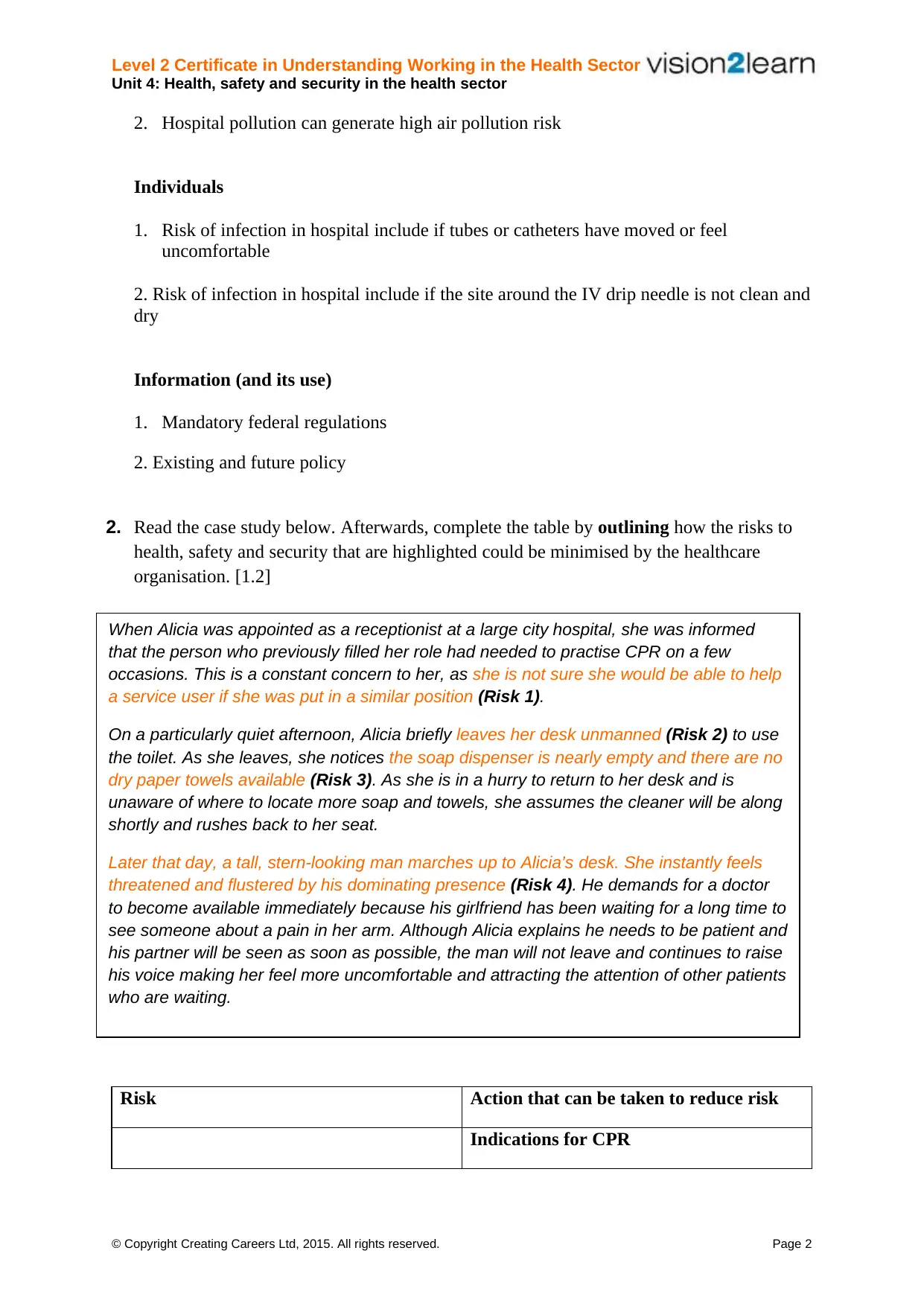
Level 2 Certificate in Understanding Working in the Health Sector
Unit 4: Health, safety and security in the health sector
2. Hospital pollution can generate high air pollution risk
Individuals
1. Risk of infection in hospital include if tubes or catheters have moved or feel
uncomfortable
2. Risk of infection in hospital include if the site around the IV drip needle is not clean and
dry
Information (and its use)
1. Mandatory federal regulations
2. Existing and future policy
2. Read the case study below. Afterwards, complete the table by outlining how the risks to
health, safety and security that are highlighted could be minimised by the healthcare
organisation. [1.2]
Risk Action that can be taken to reduce risk
Indications for CPR
© Copyright Creating Careers Ltd, 2015. All rights reserved. Page 2
When Alicia was appointed as a receptionist at a large city hospital, she was informed
that the person who previously filled her role had needed to practise CPR on a few
occasions. This is a constant concern to her, as she is not sure she would be able to help
a service user if she was put in a similar position (Risk 1).
On a particularly quiet afternoon, Alicia briefly leaves her desk unmanned (Risk 2) to use
the toilet. As she leaves, she notices the soap dispenser is nearly empty and there are no
dry paper towels available (Risk 3). As she is in a hurry to return to her desk and is
unaware of where to locate more soap and towels, she assumes the cleaner will be along
shortly and rushes back to her seat.
Later that day, a tall, stern-looking man marches up to Alicia’s desk. She instantly feels
threatened and flustered by his dominating presence (Risk 4). He demands for a doctor
to become available immediately because his girlfriend has been waiting for a long time to
see someone about a pain in her arm. Although Alicia explains he needs to be patient and
his partner will be seen as soon as possible, the man will not leave and continues to raise
his voice making her feel more uncomfortable and attracting the attention of other patients
who are waiting.
Unit 4: Health, safety and security in the health sector
2. Hospital pollution can generate high air pollution risk
Individuals
1. Risk of infection in hospital include if tubes or catheters have moved or feel
uncomfortable
2. Risk of infection in hospital include if the site around the IV drip needle is not clean and
dry
Information (and its use)
1. Mandatory federal regulations
2. Existing and future policy
2. Read the case study below. Afterwards, complete the table by outlining how the risks to
health, safety and security that are highlighted could be minimised by the healthcare
organisation. [1.2]
Risk Action that can be taken to reduce risk
Indications for CPR
© Copyright Creating Careers Ltd, 2015. All rights reserved. Page 2
When Alicia was appointed as a receptionist at a large city hospital, she was informed
that the person who previously filled her role had needed to practise CPR on a few
occasions. This is a constant concern to her, as she is not sure she would be able to help
a service user if she was put in a similar position (Risk 1).
On a particularly quiet afternoon, Alicia briefly leaves her desk unmanned (Risk 2) to use
the toilet. As she leaves, she notices the soap dispenser is nearly empty and there are no
dry paper towels available (Risk 3). As she is in a hurry to return to her desk and is
unaware of where to locate more soap and towels, she assumes the cleaner will be along
shortly and rushes back to her seat.
Later that day, a tall, stern-looking man marches up to Alicia’s desk. She instantly feels
threatened and flustered by his dominating presence (Risk 4). He demands for a doctor
to become available immediately because his girlfriend has been waiting for a long time to
see someone about a pain in her arm. Although Alicia explains he needs to be patient and
his partner will be seen as soon as possible, the man will not leave and continues to raise
his voice making her feel more uncomfortable and attracting the attention of other patients
who are waiting.
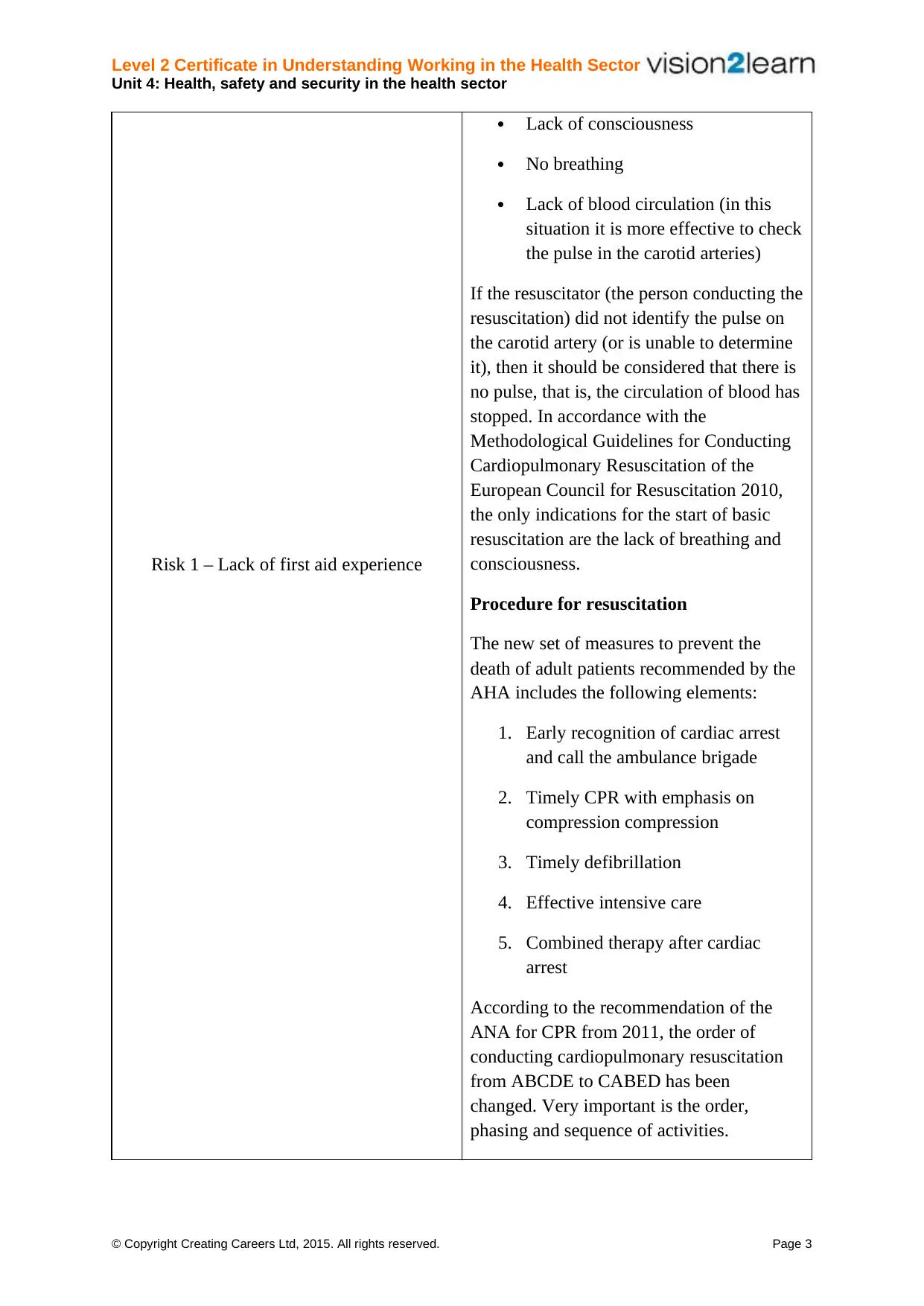
Level 2 Certificate in Understanding Working in the Health Sector
Unit 4: Health, safety and security in the health sector
Risk 1 – Lack of first aid experience
Lack of consciousness
No breathing
Lack of blood circulation (in this
situation it is more effective to check
the pulse in the carotid arteries)
If the resuscitator (the person conducting the
resuscitation) did not identify the pulse on
the carotid artery (or is unable to determine
it), then it should be considered that there is
no pulse, that is, the circulation of blood has
stopped. In accordance with the
Methodological Guidelines for Conducting
Cardiopulmonary Resuscitation of the
European Council for Resuscitation 2010,
the only indications for the start of basic
resuscitation are the lack of breathing and
consciousness.
Procedure for resuscitation
The new set of measures to prevent the
death of adult patients recommended by the
AHA includes the following elements:
1. Early recognition of cardiac arrest
and call the ambulance brigade
2. Timely CPR with emphasis on
compression compression
3. Timely defibrillation
4. Effective intensive care
5. Combined therapy after cardiac
arrest
According to the recommendation of the
ANA for CPR from 2011, the order of
conducting cardiopulmonary resuscitation
from ABCDE to CABED has been
changed. Very important is the order,
phasing and sequence of activities.
© Copyright Creating Careers Ltd, 2015. All rights reserved. Page 3
Unit 4: Health, safety and security in the health sector
Risk 1 – Lack of first aid experience
Lack of consciousness
No breathing
Lack of blood circulation (in this
situation it is more effective to check
the pulse in the carotid arteries)
If the resuscitator (the person conducting the
resuscitation) did not identify the pulse on
the carotid artery (or is unable to determine
it), then it should be considered that there is
no pulse, that is, the circulation of blood has
stopped. In accordance with the
Methodological Guidelines for Conducting
Cardiopulmonary Resuscitation of the
European Council for Resuscitation 2010,
the only indications for the start of basic
resuscitation are the lack of breathing and
consciousness.
Procedure for resuscitation
The new set of measures to prevent the
death of adult patients recommended by the
AHA includes the following elements:
1. Early recognition of cardiac arrest
and call the ambulance brigade
2. Timely CPR with emphasis on
compression compression
3. Timely defibrillation
4. Effective intensive care
5. Combined therapy after cardiac
arrest
According to the recommendation of the
ANA for CPR from 2011, the order of
conducting cardiopulmonary resuscitation
from ABCDE to CABED has been
changed. Very important is the order,
phasing and sequence of activities.
© Copyright Creating Careers Ltd, 2015. All rights reserved. Page 3
⊘ This is a preview!⊘
Do you want full access?
Subscribe today to unlock all pages.

Trusted by 1+ million students worldwide

Level 2 Certificate in Understanding Working in the Health Sector
Unit 4: Health, safety and security in the health sector
Risk 2 – Unmanned reception desk She must not leave the desk unnamed
instead Alicia must inform someone who
can take care of things in her absence.
Risk 3 –No handwashing resources
available
If the desk was not left by Alicia unnamed
and should would have informed someone
who could have taken care instead of her
during the moment she went to toilet then
risk of losing soap from dispenser and dry
paper towels could have been reduced. The
next time proposed action is to inform and
call someone to take care of the desk in
absence of Alicia.
Risk 4 – Dealing independently with a
difficult patient
In a situation when someone tries to harass
receptionist, security must be called to
control such threats.
3. Identify four examples of key legislation relating to health, safety and security in the
left-hand column of the table below.
You must also provide a brief explanation of the purpose of each piece of legislation
in the right-hand column. [1.3]
Key legislation Purpose within the health sector
1. Food and Safety Act 1990 All staff coming in contact with food must be
aware of hygiene rules, and how food should
be stored, prepared, produced and distributed
in a way that prevents germ transmission
2. Data Protection Act 1998 Controls usage and access of personal
information by government, organisation,
and business and also prevents misuse of
confidential data
3.Manual Handling Operations Regulations
1992
Outline techniques for safe manual handling
to prevent injuries
© Copyright Creating Careers Ltd, 2015. All rights reserved. Page 4
Unit 4: Health, safety and security in the health sector
Risk 2 – Unmanned reception desk She must not leave the desk unnamed
instead Alicia must inform someone who
can take care of things in her absence.
Risk 3 –No handwashing resources
available
If the desk was not left by Alicia unnamed
and should would have informed someone
who could have taken care instead of her
during the moment she went to toilet then
risk of losing soap from dispenser and dry
paper towels could have been reduced. The
next time proposed action is to inform and
call someone to take care of the desk in
absence of Alicia.
Risk 4 – Dealing independently with a
difficult patient
In a situation when someone tries to harass
receptionist, security must be called to
control such threats.
3. Identify four examples of key legislation relating to health, safety and security in the
left-hand column of the table below.
You must also provide a brief explanation of the purpose of each piece of legislation
in the right-hand column. [1.3]
Key legislation Purpose within the health sector
1. Food and Safety Act 1990 All staff coming in contact with food must be
aware of hygiene rules, and how food should
be stored, prepared, produced and distributed
in a way that prevents germ transmission
2. Data Protection Act 1998 Controls usage and access of personal
information by government, organisation,
and business and also prevents misuse of
confidential data
3.Manual Handling Operations Regulations
1992
Outline techniques for safe manual handling
to prevent injuries
© Copyright Creating Careers Ltd, 2015. All rights reserved. Page 4
Paraphrase This Document
Need a fresh take? Get an instant paraphrase of this document with our AI Paraphraser
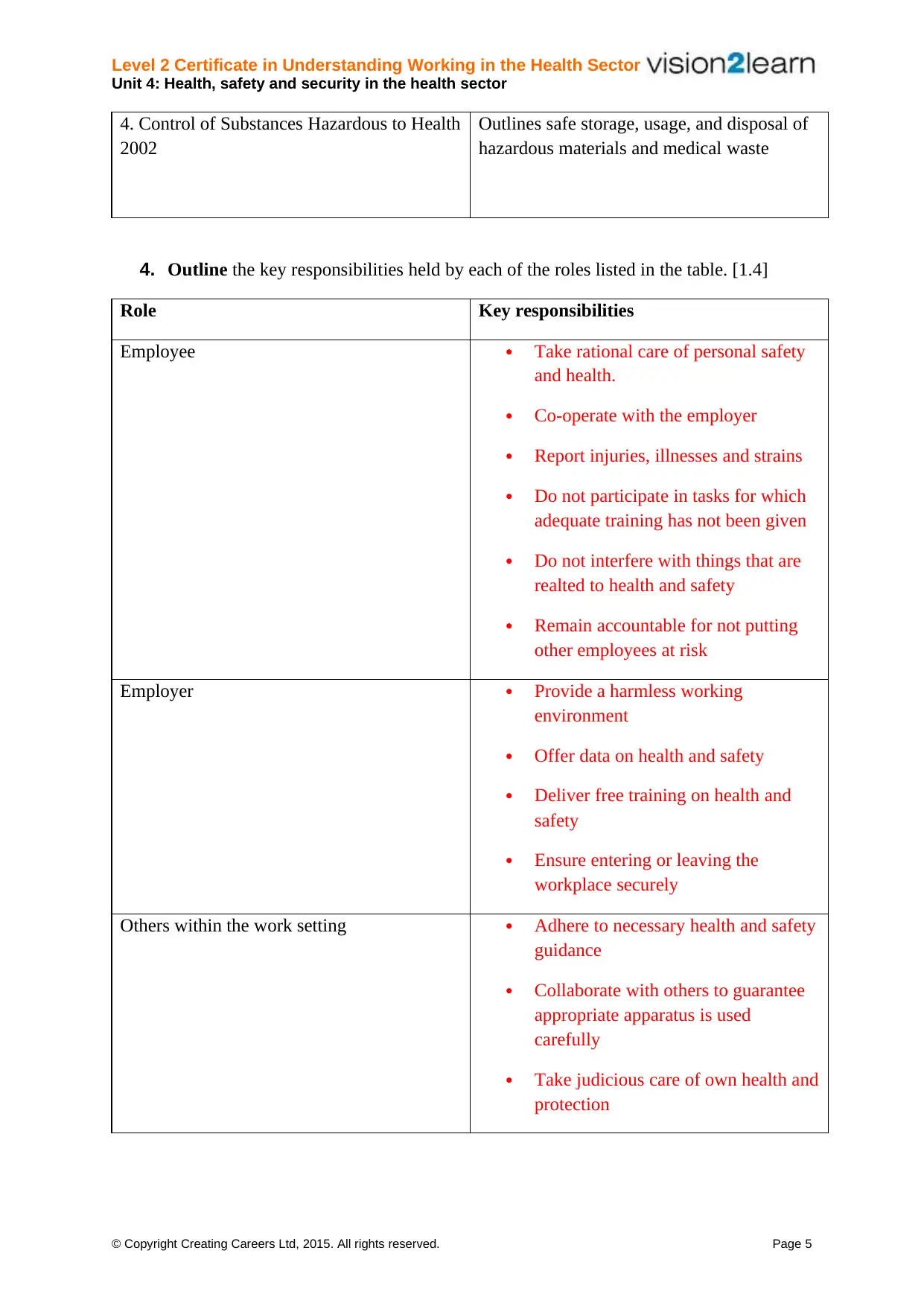
Level 2 Certificate in Understanding Working in the Health Sector
Unit 4: Health, safety and security in the health sector
4. Control of Substances Hazardous to Health
2002
Outlines safe storage, usage, and disposal of
hazardous materials and medical waste
4. Outline the key responsibilities held by each of the roles listed in the table. [1.4]
Role Key responsibilities
Employee Take rational care of personal safety
and health.
Co-operate with the employer
Report injuries, illnesses and strains
Do not participate in tasks for which
adequate training has not been given
Do not interfere with things that are
realted to health and safety
Remain accountable for not putting
other employees at risk
Employer Provide a harmless working
environment
Offer data on health and safety
Deliver free training on health and
safety
Ensure entering or leaving the
workplace securely
Others within the work setting Adhere to necessary health and safety
guidance
Collaborate with others to guarantee
appropriate apparatus is used
carefully
Take judicious care of own health and
protection
© Copyright Creating Careers Ltd, 2015. All rights reserved. Page 5
Unit 4: Health, safety and security in the health sector
4. Control of Substances Hazardous to Health
2002
Outlines safe storage, usage, and disposal of
hazardous materials and medical waste
4. Outline the key responsibilities held by each of the roles listed in the table. [1.4]
Role Key responsibilities
Employee Take rational care of personal safety
and health.
Co-operate with the employer
Report injuries, illnesses and strains
Do not participate in tasks for which
adequate training has not been given
Do not interfere with things that are
realted to health and safety
Remain accountable for not putting
other employees at risk
Employer Provide a harmless working
environment
Offer data on health and safety
Deliver free training on health and
safety
Ensure entering or leaving the
workplace securely
Others within the work setting Adhere to necessary health and safety
guidance
Collaborate with others to guarantee
appropriate apparatus is used
carefully
Take judicious care of own health and
protection
© Copyright Creating Careers Ltd, 2015. All rights reserved. Page 5

Level 2 Certificate in Understanding Working in the Health Sector
Unit 4: Health, safety and security in the health sector
5. Describe ways in which additional health and safety support can be accessed via each
of the following methods: [1.5]
Method Group or organisation offering support Description of
this service
Online
http://www.hse.gov.uk/guidance/index.htm
This organisation
provides
information and
makes it easily
accessible to its
online users.
Directly via
telephone https://www.phoenixhsc.co.uk/consultancy/telephone-
email-support
This organisation
provide
competitively-
priced telephone
and email support
packages
Within a
healthcare
organisation
HSE HSE guide to the
health and safety
regulation within
organisation
Now that you have completed part 1 of your Assessment, remember to save the work
you have done so far – you will need to send your work to your tutor for marking once
you have completed all 5 parts of this Assessment.
© Copyright Creating Careers Ltd, 2015. All rights reserved. Page 6
Unit 4: Health, safety and security in the health sector
5. Describe ways in which additional health and safety support can be accessed via each
of the following methods: [1.5]
Method Group or organisation offering support Description of
this service
Online
http://www.hse.gov.uk/guidance/index.htm
This organisation
provides
information and
makes it easily
accessible to its
online users.
Directly via
telephone https://www.phoenixhsc.co.uk/consultancy/telephone-
email-support
This organisation
provide
competitively-
priced telephone
and email support
packages
Within a
healthcare
organisation
HSE HSE guide to the
health and safety
regulation within
organisation
Now that you have completed part 1 of your Assessment, remember to save the work
you have done so far – you will need to send your work to your tutor for marking once
you have completed all 5 parts of this Assessment.
© Copyright Creating Careers Ltd, 2015. All rights reserved. Page 6
⊘ This is a preview!⊘
Do you want full access?
Subscribe today to unlock all pages.

Trusted by 1+ million students worldwide
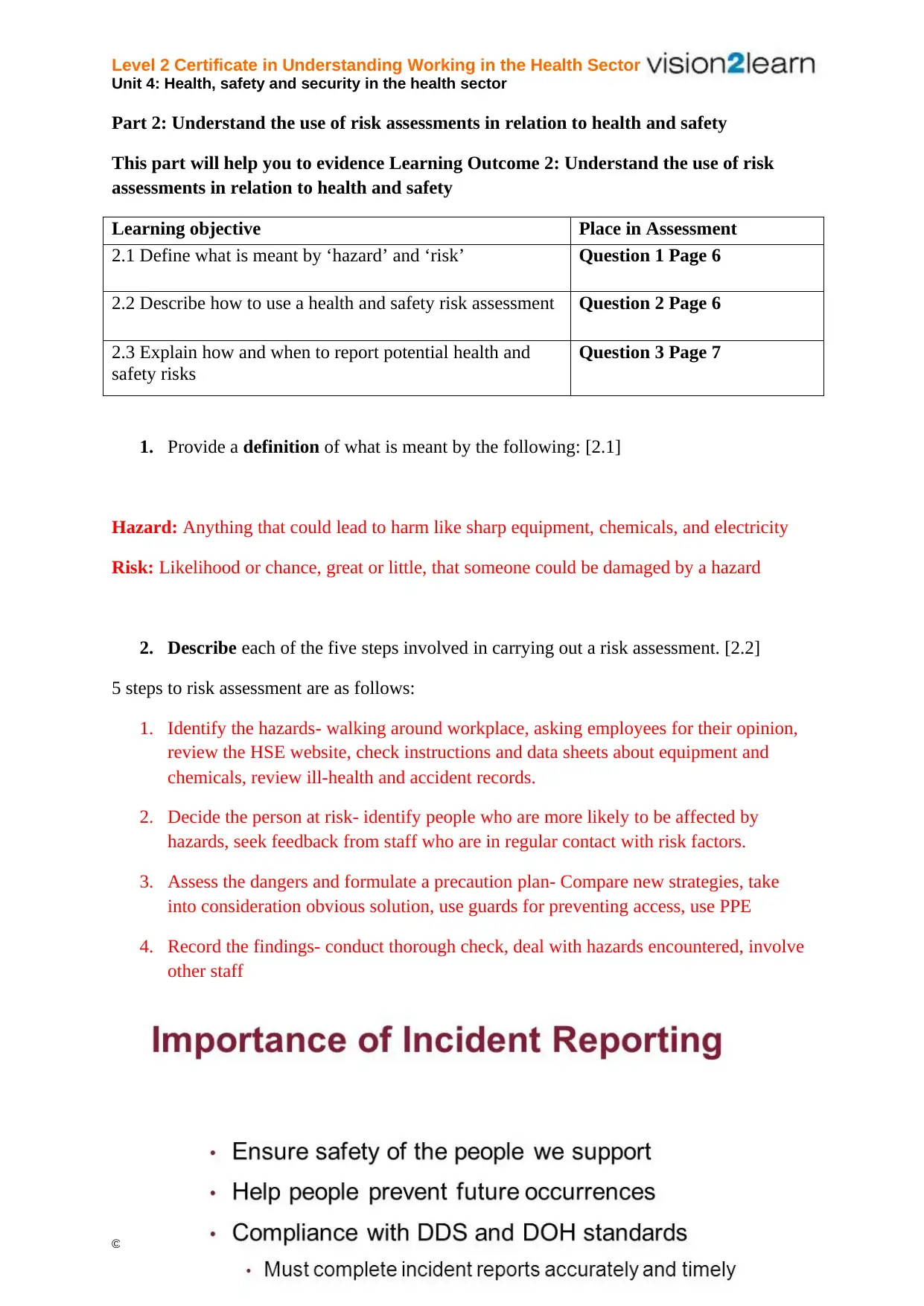
Level 2 Certificate in Understanding Working in the Health Sector
Unit 4: Health, safety and security in the health sector
Part 2: Understand the use of risk assessments in relation to health and safety
This part will help you to evidence Learning Outcome 2: Understand the use of risk
assessments in relation to health and safety
Learning objective Place in Assessment
2.1 Define what is meant by ‘hazard’ and ‘risk’ Question 1 Page 6
2.2 Describe how to use a health and safety risk assessment Question 2 Page 6
2.3 Explain how and when to report potential health and
safety risks
Question 3 Page 7
1. Provide a definition of what is meant by the following: [2.1]
Hazard: Anything that could lead to harm like sharp equipment, chemicals, and electricity
Risk: Likelihood or chance, great or little, that someone could be damaged by a hazard
2. Describe each of the five steps involved in carrying out a risk assessment. [2.2]
5 steps to risk assessment are as follows:
1. Identify the hazards- walking around workplace, asking employees for their opinion,
review the HSE website, check instructions and data sheets about equipment and
chemicals, review ill-health and accident records.
2. Decide the person at risk- identify people who are more likely to be affected by
hazards, seek feedback from staff who are in regular contact with risk factors.
3. Assess the dangers and formulate a precaution plan- Compare new strategies, take
into consideration obvious solution, use guards for preventing access, use PPE
4. Record the findings- conduct thorough check, deal with hazards encountered, involve
other staff
5. Conduct review assessment and implement changes- analyse the risk assessment,
record new things learnt and problems that were not spotted.
3. In the left-hand column state identified risks that should be reported.
In the right-hand column, explain ways in which your three identified risks can be
communicated to others as well as when they should be reported. [2.3]
© Copyright Creating Careers Ltd, 2015. All rights reserved. Page 7
Unit 4: Health, safety and security in the health sector
Part 2: Understand the use of risk assessments in relation to health and safety
This part will help you to evidence Learning Outcome 2: Understand the use of risk
assessments in relation to health and safety
Learning objective Place in Assessment
2.1 Define what is meant by ‘hazard’ and ‘risk’ Question 1 Page 6
2.2 Describe how to use a health and safety risk assessment Question 2 Page 6
2.3 Explain how and when to report potential health and
safety risks
Question 3 Page 7
1. Provide a definition of what is meant by the following: [2.1]
Hazard: Anything that could lead to harm like sharp equipment, chemicals, and electricity
Risk: Likelihood or chance, great or little, that someone could be damaged by a hazard
2. Describe each of the five steps involved in carrying out a risk assessment. [2.2]
5 steps to risk assessment are as follows:
1. Identify the hazards- walking around workplace, asking employees for their opinion,
review the HSE website, check instructions and data sheets about equipment and
chemicals, review ill-health and accident records.
2. Decide the person at risk- identify people who are more likely to be affected by
hazards, seek feedback from staff who are in regular contact with risk factors.
3. Assess the dangers and formulate a precaution plan- Compare new strategies, take
into consideration obvious solution, use guards for preventing access, use PPE
4. Record the findings- conduct thorough check, deal with hazards encountered, involve
other staff
5. Conduct review assessment and implement changes- analyse the risk assessment,
record new things learnt and problems that were not spotted.
3. In the left-hand column state identified risks that should be reported.
In the right-hand column, explain ways in which your three identified risks can be
communicated to others as well as when they should be reported. [2.3]
© Copyright Creating Careers Ltd, 2015. All rights reserved. Page 7
Paraphrase This Document
Need a fresh take? Get an instant paraphrase of this document with our AI Paraphraser

Level 2 Certificate in Understanding Working in the Health Sector
Unit 4: Health, safety and security in the health sector
Risks Communication of risks When to report
Chemical hazards like fumes,
gases, vapours, and liquids
Distributing opies of the risk
assessment
On conducting risk
assessment
Physical hazards like slippery
floors, clustered walkways,
poor lighting
Seeking explanation from
senior staff
On conducting risk
assessment
Ergonomic hazards like poor
equipment design, workflow,
manual handling, repetitive
movement
Using translators, diagrams
or photographs
On conducting risk
assessment
Now that you have completed part 2 of your Assessment, remember to save the work
you have done so far – you will need to send your work to your tutor for marking once
you have completed all 5 parts of this Assessment.
© Copyright Creating Careers Ltd, 2015. All rights reserved. Page 8
Unit 4: Health, safety and security in the health sector
Risks Communication of risks When to report
Chemical hazards like fumes,
gases, vapours, and liquids
Distributing opies of the risk
assessment
On conducting risk
assessment
Physical hazards like slippery
floors, clustered walkways,
poor lighting
Seeking explanation from
senior staff
On conducting risk
assessment
Ergonomic hazards like poor
equipment design, workflow,
manual handling, repetitive
movement
Using translators, diagrams
or photographs
On conducting risk
assessment
Now that you have completed part 2 of your Assessment, remember to save the work
you have done so far – you will need to send your work to your tutor for marking once
you have completed all 5 parts of this Assessment.
© Copyright Creating Careers Ltd, 2015. All rights reserved. Page 8
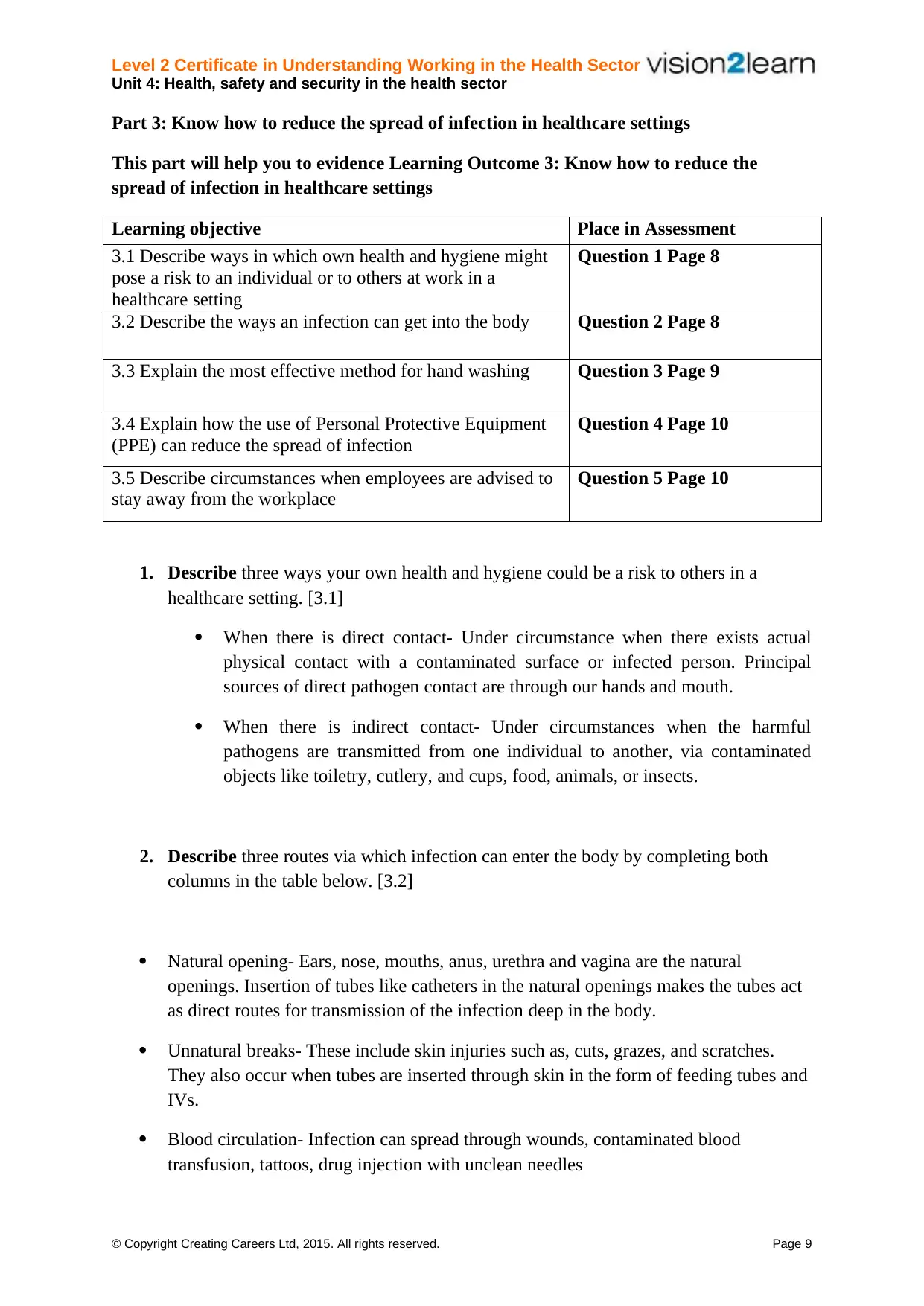
Level 2 Certificate in Understanding Working in the Health Sector
Unit 4: Health, safety and security in the health sector
Part 3: Know how to reduce the spread of infection in healthcare settings
This part will help you to evidence Learning Outcome 3: Know how to reduce the
spread of infection in healthcare settings
Learning objective Place in Assessment
3.1 Describe ways in which own health and hygiene might
pose a risk to an individual or to others at work in a
healthcare setting
Question 1 Page 8
3.2 Describe the ways an infection can get into the body Question 2 Page 8
3.3 Explain the most effective method for hand washing Question 3 Page 9
3.4 Explain how the use of Personal Protective Equipment
(PPE) can reduce the spread of infection
Question 4 Page 10
3.5 Describe circumstances when employees are advised to
stay away from the workplace
Question 5 Page 10
1. Describe three ways your own health and hygiene could be a risk to others in a
healthcare setting. [3.1]
When there is direct contact- Under circumstance when there exists actual
physical contact with a contaminated surface or infected person. Principal
sources of direct pathogen contact are through our hands and mouth.
When there is indirect contact- Under circumstances when the harmful
pathogens are transmitted from one individual to another, via contaminated
objects like toiletry, cutlery, and cups, food, animals, or insects.
2. Describe three routes via which infection can enter the body by completing both
columns in the table below. [3.2]
Natural opening- Ears, nose, mouths, anus, urethra and vagina are the natural
openings. Insertion of tubes like catheters in the natural openings makes the tubes act
as direct routes for transmission of the infection deep in the body.
Unnatural breaks- These include skin injuries such as, cuts, grazes, and scratches.
They also occur when tubes are inserted through skin in the form of feeding tubes and
IVs.
Blood circulation- Infection can spread through wounds, contaminated blood
transfusion, tattoos, drug injection with unclean needles
© Copyright Creating Careers Ltd, 2015. All rights reserved. Page 9
Unit 4: Health, safety and security in the health sector
Part 3: Know how to reduce the spread of infection in healthcare settings
This part will help you to evidence Learning Outcome 3: Know how to reduce the
spread of infection in healthcare settings
Learning objective Place in Assessment
3.1 Describe ways in which own health and hygiene might
pose a risk to an individual or to others at work in a
healthcare setting
Question 1 Page 8
3.2 Describe the ways an infection can get into the body Question 2 Page 8
3.3 Explain the most effective method for hand washing Question 3 Page 9
3.4 Explain how the use of Personal Protective Equipment
(PPE) can reduce the spread of infection
Question 4 Page 10
3.5 Describe circumstances when employees are advised to
stay away from the workplace
Question 5 Page 10
1. Describe three ways your own health and hygiene could be a risk to others in a
healthcare setting. [3.1]
When there is direct contact- Under circumstance when there exists actual
physical contact with a contaminated surface or infected person. Principal
sources of direct pathogen contact are through our hands and mouth.
When there is indirect contact- Under circumstances when the harmful
pathogens are transmitted from one individual to another, via contaminated
objects like toiletry, cutlery, and cups, food, animals, or insects.
2. Describe three routes via which infection can enter the body by completing both
columns in the table below. [3.2]
Natural opening- Ears, nose, mouths, anus, urethra and vagina are the natural
openings. Insertion of tubes like catheters in the natural openings makes the tubes act
as direct routes for transmission of the infection deep in the body.
Unnatural breaks- These include skin injuries such as, cuts, grazes, and scratches.
They also occur when tubes are inserted through skin in the form of feeding tubes and
IVs.
Blood circulation- Infection can spread through wounds, contaminated blood
transfusion, tattoos, drug injection with unclean needles
© Copyright Creating Careers Ltd, 2015. All rights reserved. Page 9
⊘ This is a preview!⊘
Do you want full access?
Subscribe today to unlock all pages.

Trusted by 1+ million students worldwide
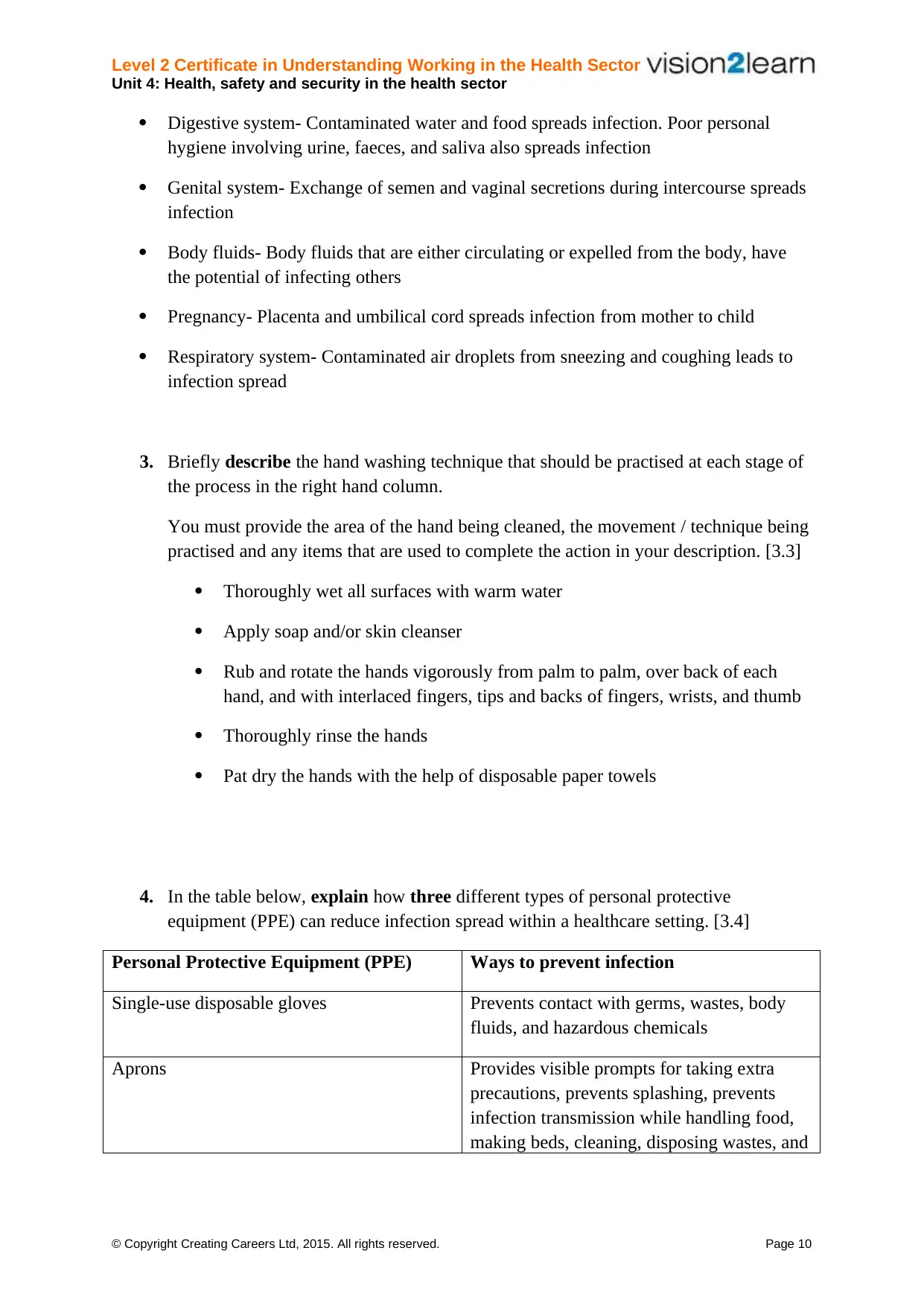
Level 2 Certificate in Understanding Working in the Health Sector
Unit 4: Health, safety and security in the health sector
Digestive system- Contaminated water and food spreads infection. Poor personal
hygiene involving urine, faeces, and saliva also spreads infection
Genital system- Exchange of semen and vaginal secretions during intercourse spreads
infection
Body fluids- Body fluids that are either circulating or expelled from the body, have
the potential of infecting others
Pregnancy- Placenta and umbilical cord spreads infection from mother to child
Respiratory system- Contaminated air droplets from sneezing and coughing leads to
infection spread
3. Briefly describe the hand washing technique that should be practised at each stage of
the process in the right hand column.
You must provide the area of the hand being cleaned, the movement / technique being
practised and any items that are used to complete the action in your description. [3.3]
Thoroughly wet all surfaces with warm water
Apply soap and/or skin cleanser
Rub and rotate the hands vigorously from palm to palm, over back of each
hand, and with interlaced fingers, tips and backs of fingers, wrists, and thumb
Thoroughly rinse the hands
Pat dry the hands with the help of disposable paper towels
4. In the table below, explain how three different types of personal protective
equipment (PPE) can reduce infection spread within a healthcare setting. [3.4]
Personal Protective Equipment (PPE) Ways to prevent infection
Single-use disposable gloves Prevents contact with germs, wastes, body
fluids, and hazardous chemicals
Aprons Provides visible prompts for taking extra
precautions, prevents splashing, prevents
infection transmission while handling food,
making beds, cleaning, disposing wastes, and
© Copyright Creating Careers Ltd, 2015. All rights reserved. Page 10
Unit 4: Health, safety and security in the health sector
Digestive system- Contaminated water and food spreads infection. Poor personal
hygiene involving urine, faeces, and saliva also spreads infection
Genital system- Exchange of semen and vaginal secretions during intercourse spreads
infection
Body fluids- Body fluids that are either circulating or expelled from the body, have
the potential of infecting others
Pregnancy- Placenta and umbilical cord spreads infection from mother to child
Respiratory system- Contaminated air droplets from sneezing and coughing leads to
infection spread
3. Briefly describe the hand washing technique that should be practised at each stage of
the process in the right hand column.
You must provide the area of the hand being cleaned, the movement / technique being
practised and any items that are used to complete the action in your description. [3.3]
Thoroughly wet all surfaces with warm water
Apply soap and/or skin cleanser
Rub and rotate the hands vigorously from palm to palm, over back of each
hand, and with interlaced fingers, tips and backs of fingers, wrists, and thumb
Thoroughly rinse the hands
Pat dry the hands with the help of disposable paper towels
4. In the table below, explain how three different types of personal protective
equipment (PPE) can reduce infection spread within a healthcare setting. [3.4]
Personal Protective Equipment (PPE) Ways to prevent infection
Single-use disposable gloves Prevents contact with germs, wastes, body
fluids, and hazardous chemicals
Aprons Provides visible prompts for taking extra
precautions, prevents splashing, prevents
infection transmission while handling food,
making beds, cleaning, disposing wastes, and
© Copyright Creating Careers Ltd, 2015. All rights reserved. Page 10
Paraphrase This Document
Need a fresh take? Get an instant paraphrase of this document with our AI Paraphraser
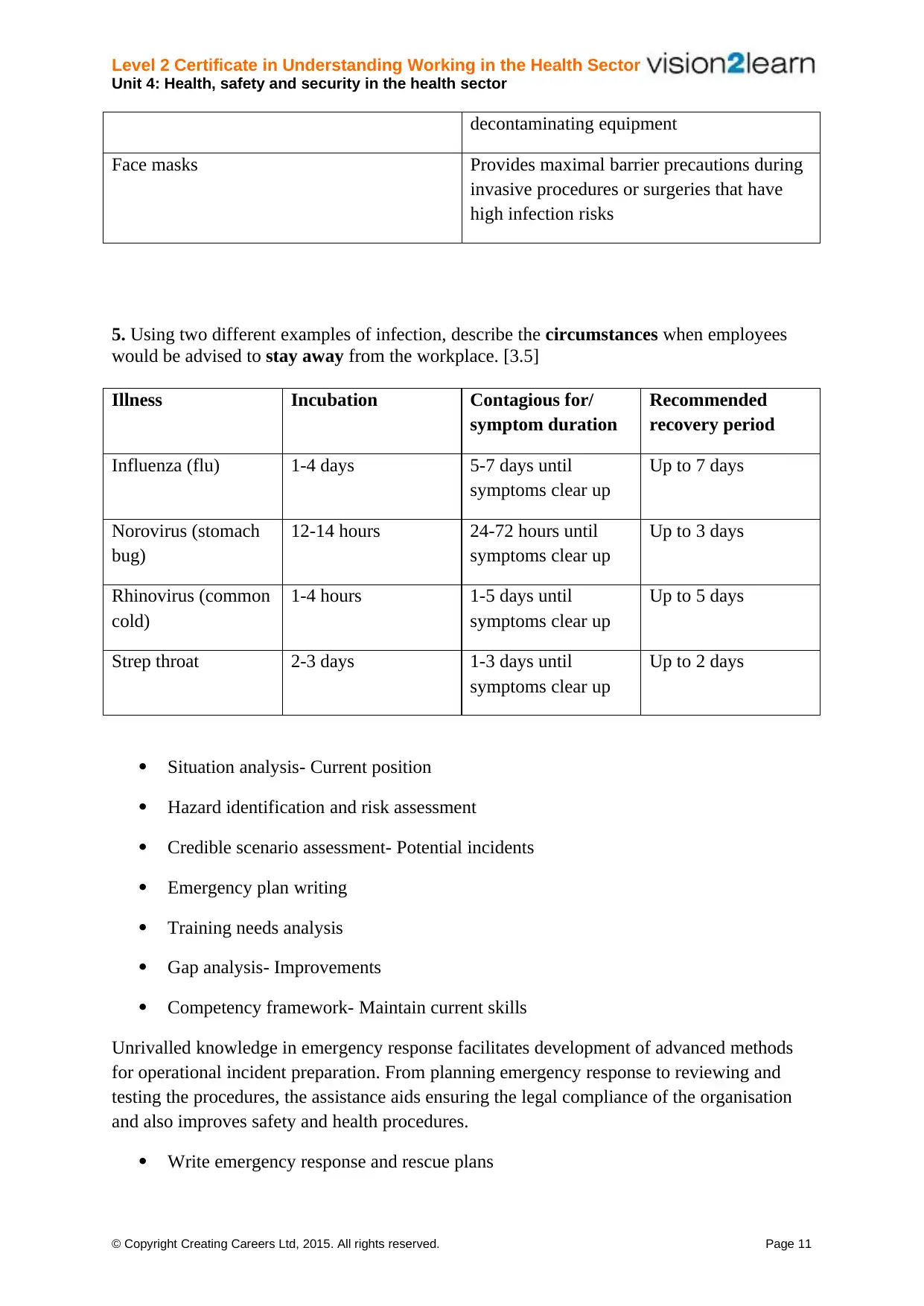
Level 2 Certificate in Understanding Working in the Health Sector
Unit 4: Health, safety and security in the health sector
decontaminating equipment
Face masks Provides maximal barrier precautions during
invasive procedures or surgeries that have
high infection risks
5. Using two different examples of infection, describe the circumstances when employees
would be advised to stay away from the workplace. [3.5]
Illness Incubation Contagious for/
symptom duration
Recommended
recovery period
Influenza (flu) 1-4 days 5-7 days until
symptoms clear up
Up to 7 days
Norovirus (stomach
bug)
12-14 hours 24-72 hours until
symptoms clear up
Up to 3 days
Rhinovirus (common
cold)
1-4 hours 1-5 days until
symptoms clear up
Up to 5 days
Strep throat 2-3 days 1-3 days until
symptoms clear up
Up to 2 days
Situation analysis- Current position
Hazard identification and risk assessment
Credible scenario assessment- Potential incidents
Emergency plan writing
Training needs analysis
Gap analysis- Improvements
Competency framework- Maintain current skills
Unrivalled knowledge in emergency response facilitates development of advanced methods
for operational incident preparation. From planning emergency response to reviewing and
testing the procedures, the assistance aids ensuring the legal compliance of the organisation
and also improves safety and health procedures.
Write emergency response and rescue plans
© Copyright Creating Careers Ltd, 2015. All rights reserved. Page 11
Unit 4: Health, safety and security in the health sector
decontaminating equipment
Face masks Provides maximal barrier precautions during
invasive procedures or surgeries that have
high infection risks
5. Using two different examples of infection, describe the circumstances when employees
would be advised to stay away from the workplace. [3.5]
Illness Incubation Contagious for/
symptom duration
Recommended
recovery period
Influenza (flu) 1-4 days 5-7 days until
symptoms clear up
Up to 7 days
Norovirus (stomach
bug)
12-14 hours 24-72 hours until
symptoms clear up
Up to 3 days
Rhinovirus (common
cold)
1-4 hours 1-5 days until
symptoms clear up
Up to 5 days
Strep throat 2-3 days 1-3 days until
symptoms clear up
Up to 2 days
Situation analysis- Current position
Hazard identification and risk assessment
Credible scenario assessment- Potential incidents
Emergency plan writing
Training needs analysis
Gap analysis- Improvements
Competency framework- Maintain current skills
Unrivalled knowledge in emergency response facilitates development of advanced methods
for operational incident preparation. From planning emergency response to reviewing and
testing the procedures, the assistance aids ensuring the legal compliance of the organisation
and also improves safety and health procedures.
Write emergency response and rescue plans
© Copyright Creating Careers Ltd, 2015. All rights reserved. Page 11
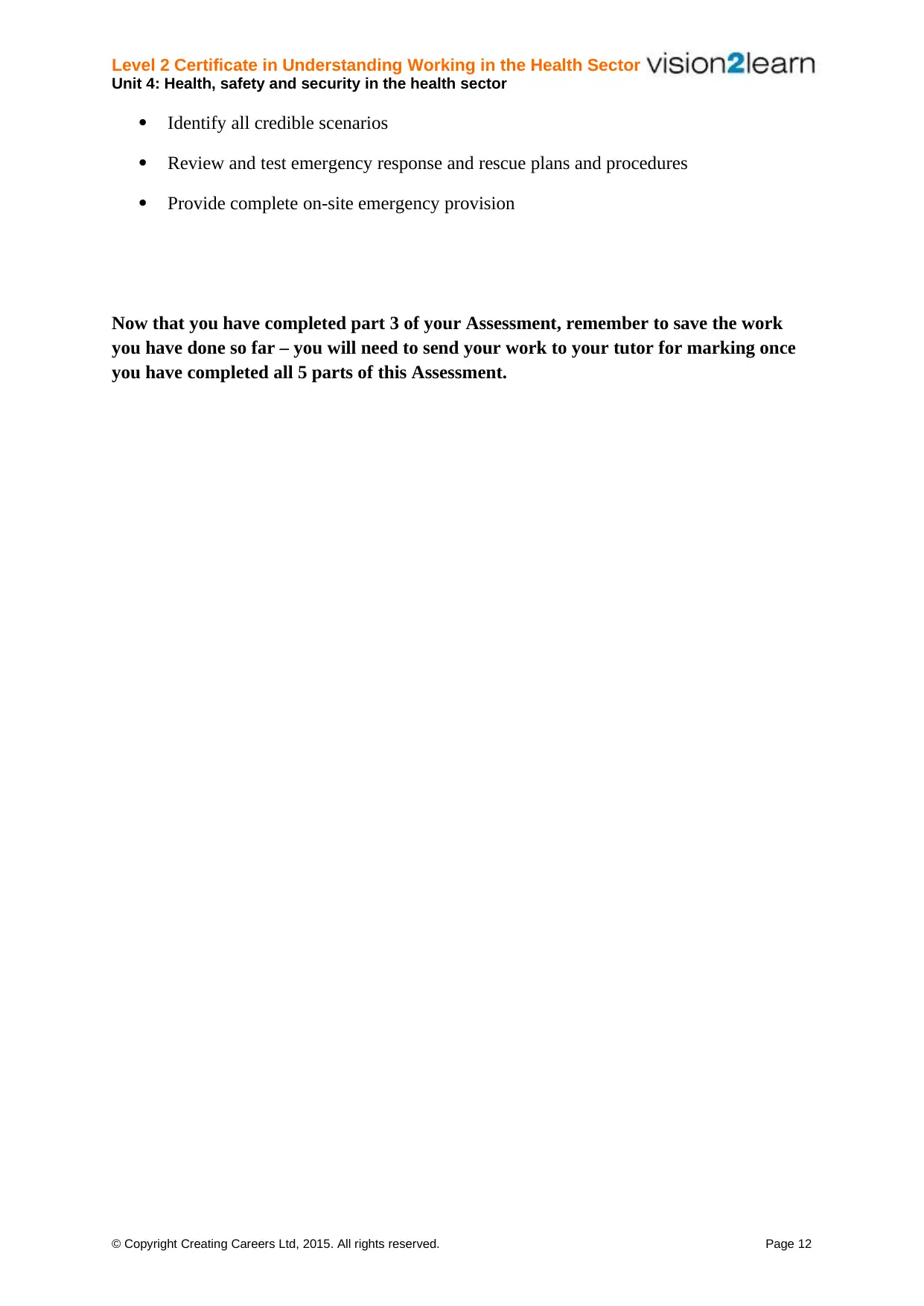
Level 2 Certificate in Understanding Working in the Health Sector
Unit 4: Health, safety and security in the health sector
Identify all credible scenarios
Review and test emergency response and rescue plans and procedures
Provide complete on-site emergency provision
Now that you have completed part 3 of your Assessment, remember to save the work
you have done so far – you will need to send your work to your tutor for marking once
you have completed all 5 parts of this Assessment.
© Copyright Creating Careers Ltd, 2015. All rights reserved. Page 12
Unit 4: Health, safety and security in the health sector
Identify all credible scenarios
Review and test emergency response and rescue plans and procedures
Provide complete on-site emergency provision
Now that you have completed part 3 of your Assessment, remember to save the work
you have done so far – you will need to send your work to your tutor for marking once
you have completed all 5 parts of this Assessment.
© Copyright Creating Careers Ltd, 2015. All rights reserved. Page 12
⊘ This is a preview!⊘
Do you want full access?
Subscribe today to unlock all pages.

Trusted by 1+ million students worldwide
1 out of 19
Related Documents
Your All-in-One AI-Powered Toolkit for Academic Success.
+13062052269
info@desklib.com
Available 24*7 on WhatsApp / Email
![[object Object]](/_next/static/media/star-bottom.7253800d.svg)
Unlock your academic potential
Copyright © 2020–2025 A2Z Services. All Rights Reserved. Developed and managed by ZUCOL.





